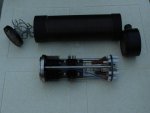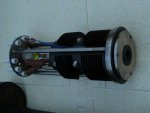^ yes, cause the efficency of most of the gas lasers is in part a function of the lenght of the cavity, and part about the diameter of the beam (sorry, don't know how to say it more technically

)
But considerate that also the surface of the cathode have part in the temperature dissipation, and that one looks big ..... other than this, as i've said, the tube is enclosed in a second tube ..... in closed tubes, the external metal tube is usually glued to the glass tube, increasing the dissipation, but not in this one, so it probably need to be more dissipated inside ..... also, note that the alignment of the tube is made with these big screws that are in the dissipator (the 8 screws placed in 2 rings of 4, at cross, are the ones that hold the tube in the dissipator and that change its alignment) ..... so, the other possibility is that is not finned for cool the tube, but for keep cooled the aluminium tube itself, for minimize the disalignment due to temperature change (any metals, more or less, change shape with thermic variations, and cause the alignment screws are in that tube, is possible that, if it become too hot, it disalign the inside tube)
Other than this ..... it's just a personal impression, or the angle of these Brewster windows is a bit different than the ones of red lasers ? ..... i mean, i can be in error, cause i only have this pic to see, but these windows looks like 30 degrees ..... and usually the different colors of the He-Ne lasers are obtained with different inclinations of these windows ..... but may also depend from what material is used for the windows, so it may also means nothing







